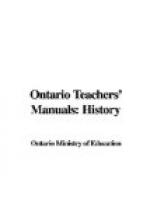Place the map of the world before the pupils and inquire how men travel to-day from Great Britain to India. Show that these routes were not feasible then. The route through the Mediterranean to Asia Minor and thence overland, or through the Red Sea to India, was closed by the Turks, who captured Constantinople in 1453. The Suez Canal was not opened till 1869. The way round the Cape of Good Hope was not discovered till 1497. The western route across the Atlantic and the Pacific was unknown.
Not till the closing years of the fifteenth century were the attempts to solve this problem successful. The discovery of the route to India by Vasco de Gama in 1497 first opened the way to the East, though the still earlier discovery by Columbus was to afford, in later years, a much more complete solution.
Christopher Columbus was a native of Genoa in Italy. An eager student of geography, he became convinced that the earth was a sphere or globe and not a flat surface. He believed that he could reach India and Cathay by sailing west, as well as by going east through the Mediterranean—a route that had been closed since the capture of Constantinople by the Turks in 1453. “This grand idea, together with his services in carrying it out, he offered first to his motherland of Genoa. But Genoa did not want a new route to the East. Then he turned, but in vain, to Portugal. The hopes of Portugal were set upon a passage around the south of Africa. To England and to France Columbus held out his wondrous offer; but these countries were slow and unbelieving. It was to Spain he made his most persistent appeal; and Spain, to his imperishable glory, gave ear.” Through the self-denial and devotion of Queen Isabella of Castile he was enabled to put his dream to the test.
A special lesson should be given on the life of Columbus—his efforts, perseverance, courage, failures, successes. The teacher may add at will to the facts given here. Read Joaquin Miller’s Poem, “Columbus,” High School Reader, pp. 143-145.
When Columbus landed on the island-fringe of America in 1492, he thought he had found what he had set out to find—the eastern country of India; and he believed it all his life. This idea survived for several generations, partly because of the great wealth of Mexico and Peru. When Europeans were at last convinced that it was not India, they began again to seek a way to the East, and looked on the continent of America merely as an obstacle in their path. To find the road to Cathay was still their chief ambition.
In 1497, John Cabot, under a charter from Henry VII of England, set out to find a way to the East, and landed on North America; in 1498, his son, Sebastian Cabot, explored the coast from Labrador to South Carolina, with the same object.
In 1534, on his first voyage, Cartier thought, when he arrived at Gaspe and saw the great river coming from the west, that he had discovered the gateway to the East.




